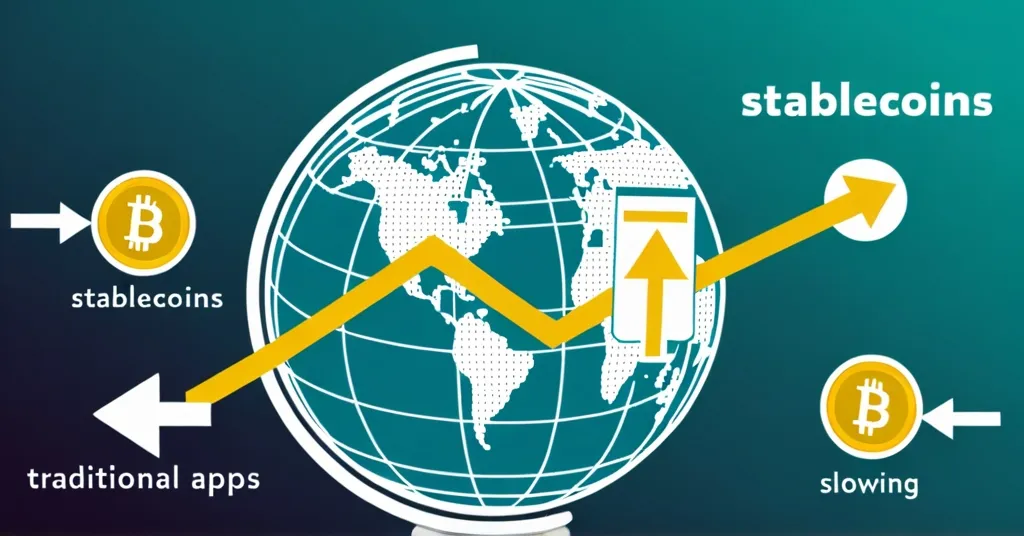Stablecoins Revolutionize Cross-Border Remittances, Outpacing Traditional Apps

Stablecoins Surge as the New Frontier for Cross-Border Remittances
In 2024, the financial landscape saw a significant shift as traditional remittance apps experienced a decline in usage, while stablecoins reached unprecedented heights, revolutionizing the cross-border payment sector. This transition, driven by the efficiency and lower costs of stablecoins, marks a pivotal moment in the quest for faster and more affordable international transfers.
- Remittance apps see a slowdown in 2024.
- Stablecoin supply hits a new peak in early 2025.
- Stablecoins offer quicker and cheaper transfers.
- Remittance market to grow by 3.93% in 2025.
The decline in remittance app downloads throughout 2024 was stark, reversing years of consistent growth. In contrast, stablecoins like USDT and USDC have not only increased in supply to a staggering 200.7 billion by January 2025 but have also facilitated a record-breaking $28.7 trillion in total transfers. This surge highlights their growing capacity to handle vast sums, making them increasingly appealing for remittances.
Matthew Sigel, head of digital assets research at VanEck, has noted this shift, stating, “The decline in traditional remittance app usage may benefit stablecoin adoption.” Countries like India, Mexico, China, and the Philippines, known for their crypto-friendly environments, are at the forefront of this trend. In 2024 alone, these nations received an estimated $685 billion in remittances, with India topping the list at $129.1 billion.
Stablecoins, cryptocurrencies designed to have minimal volatility and often pegged to stable assets like the US dollar, offer clear advantages in the remittance sector. They provide transactions with virtually negligible fees and no commissions, a significant improvement over the often high costs associated with traditional methods. Networks like TRON and BSC have become popular for stablecoin transactions due to their low transaction fees, further enhancing their appeal. Stablecoins are like the Swiss Army knife of cross-border payments—versatile, reliable, and always ready for action.
Despite the competition, the remittance market is still poised for growth, with a projected increase of 3.93% in 2025. However, stablecoins are set to capture a significant share of this market, thanks to their efficiency and cost-effectiveness. The rise in global crypto ownership, reaching 560 million with a 6.8% growth in 2024, also supports the increasing use of stablecoins for direct payments and remittances, with over 65% of their activity unrelated to peer-to-peer crypto trading platforms without a central authority or centralized markets.
The political landscape may further influence this trend. With the election of Donald Trump and discussions surrounding a potential remittance tax, interest in crypto-based remittances could increase as individuals seek to bypass traditional financial channels. Have you ever wondered how to send money abroad without paying hefty fees? Stablecoins might just be your answer, especially considering the impact of Donald Trump’s remittance tax on stablecoin adoption.
Yet, it’s crucial to remain vigilant. While stablecoins offer exciting opportunities, the collapse of TerraUSD in 2022 serves as a reminder of the risks involved. Regulatory environments, such as the European Union’s Markets in Cryptoassets (MiCA) rules and the lack of a unified federal regulatory regime in the US, will play a significant role in shaping the future of stablecoin adoption. Companies like Visa, PayPal, and Stripe are already investing in stablecoin projects, indicating a growing mainstream interest.
The rise of stablecoins as a tool for remittances is not without its challenges. Fees can vary significantly based on the blockchain network used, with USDT on Ethereum potentially incurring higher fees due to network congestion. Additionally, USDT’s market dominance could face challenges in 2025 due to regulatory issues and competition. Say goodbye to bank fees that feel like highway robbery, but don’t forget to keep an eye on the fine print. For more insights, check out stablecoins for cross-border payments.
Nevertheless, the potential for stablecoins to revolutionize cross-border payments remains undeniable. As we look forward, the projected doubling of stablecoin supply in 2025 and the continued growth of the remittance market point to a future where stablecoins could become the norm for international transfers.
Key Takeaways and Questions
- What trends are observed in remittance app usage in 2024?
Remittance app usage slowed down after years of growth.
- How has the stablecoin market expanded in 2024?
Stablecoin supply reached a new peak of 200.7 billion, with total transfer volume at $28.7 trillion.
- What advantages do stablecoins offer for cross-border payments?
Stablecoins provide faster transfers with virtually negligible fees and no commissions.
- Which countries are major recipients of remittances and crypto-friendly?
India, Mexico, China, and the Philippines are major recipients and known for being crypto-friendly.
- How might political events influence the adoption of stablecoins for remittances?
The election of Donald Trump and discussions of a remittance tax may increase interest in stablecoins for remittances.
- What is the expected growth of the remittance market in 2025?
The remittance market is expected to grow by 3.93% in 2025.
- What is the current state of crypto ownership globally?
Crypto ownership reached 560 million in the past year, growing by 6.8% in 2024.
As we navigate this evolving financial landscape, the rise of stablecoins offers a glimpse into a future where decentralization and efficiency could redefine how we send and receive money across borders. While the journey is not without its bumps, the potential for a more inclusive and accessible financial system is a cause for cautious optimism.



